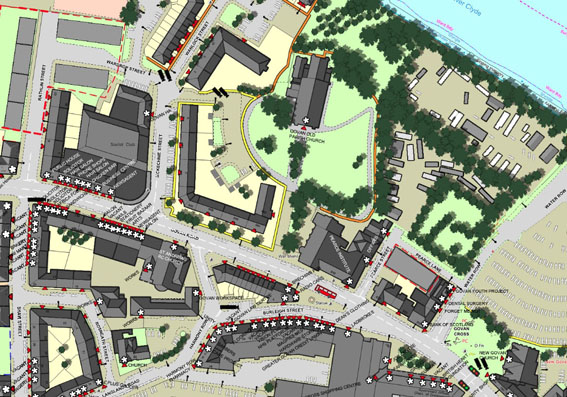
Students: Gareth Jackson, Raymond Brown, William Ewing, John MacLean.
From the Brief:
“Scope:
It is surprising how often entire projects are presented without the slightest appraisal of what is in place before the project is done. This happens in the professional practice, but even more often in academia, where the study of the original urban context is almost everywhere, every time, disregarded. That tells a lot on how low is the consideration of most designers for the endless complexity of layered values and memories that are always embedded even in the poorest urban setting.
“Design professionals today are often part of the problem. In too many cases, we design for places and people we do not know and grant them very little power or acknowledgment. Too many professionals are more part of a universal professional culture than part of the local cultures for whom we produce our plans and products. We carry our ‘bag of tricks’ around the world and bring them out wherever we land. This floating professional culture has only the most superficial conception of particular place. Rootless, it is more susceptible to changes in professional fashion and theory than to local events. There is too little inquiry, too much proposing. Quick surveys are made, instant solutions devised, and the rest of the time is spent persuading the clients.” (Jacobs and Appleyard, 1987, p.115).
Allan Jacobs and Donald Appleyard labelled this attitude “rootless professionalism”, and identified it as one of the 8 problems of modern Urban Design. More than 20 years have passed after this enlightening “Urban Design Manifesto”, which was significantly elaborated out of a course of “Theories of urban form” at UC Berkeley. Things have been getting worse and worse since then and we are now witnessing the triumph of the most rootless, mindless and senseless architecture of all times, an endless childish media-game where the logics of appearance at any cost pave the way to the emergence of an “architecture of the absurd” (Silber, 2007).
Needless saying, first to be forgotten in this media game is real people in their real environment, and the more than real stratification of social values, memories, symbols, practices, habits and mutually sensible dynamics in general that simply make a place what it is and a community of humans what it has always been.
We want our students to learn that a good urban project is based on knowledge and respect for what is in place, even if it challenges our own values and ways of thinking. The first step to do that is to represent the place
Objectives:
- To draw the entire urban district of Govan in a 1:1000 scaled plan, following a legend that covers structural aspects of the built environment such as pavement, fencings, entrances, vegetation, traffic signs (vertical and horizontal), and ground floor uses.
- To enhance the awareness of all students of the complexity and depth of the urban “material” on which they are called to envision and produce change.
- To build up an essential basis for the development of all successive phases, including in particular that of Masterplanning in the second semester”.


